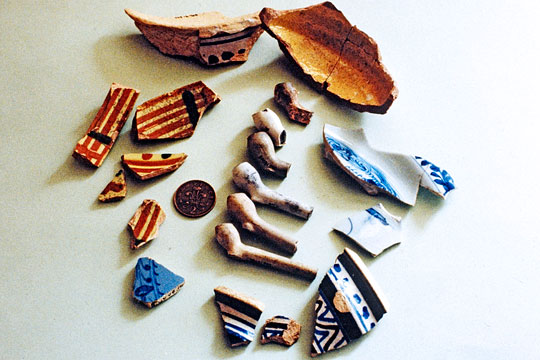Research on Berry Pomeroy Castle
Our understanding of the history of Berry Pomeroy Castle has been transformed during the past 20 years by archaeology and by documentary research.

Recent Work
Berry Pomeroy is now known to be a later 15th-century fortress on a previously unused site, adapted into a mansion in several stages between about 1560 and about 1610. It was previously wrongly believed to be a castle of Norman origin, transformed into a Tudor mansion by Protector Somerset between 1547 and 1552. Versions of these misconceptions are still perpetuated in many publications and websites.
The transformation of our knowledge of the castle’s history resulted from the series of archaeological excavations, covering about half its surface area, begun in 1980 and effectively completed by 1996, latterly under the direction of Stewart Brown. The results of these, together with thorough surveys of the standing structure, specialist reports on the finds, rediscovered wall-painting, gunports and dendrochronology, and an exhaustive documentary history by Jean Manco, were published by the Devon Archaeological Society in 1996.[1]
Much new light has also been shed on the later 17th-century use and history of the castle by the comprehensive room-by-room inventory of the property made on Sir Edward’s death in 1688, recently rediscovered in its complete form,[2] and by the Revd John Prince’s manuscript biography of Sir Edward Seymour IV. The latter is contained in a second, unpublished manuscript volume of Prince’s Worthies of Devon,[3] seemingly first noticed during the compilation of the 2011 English Heritage guidebook to the castle.[4]
Outstanding Research Questions
Areas of Berry Pomeroy’s history which would warrant further research include:
- The precise date of Pomeroy castle’s foundation. At present we know only that it was founded at some time between 1461 and 1496, and most probably during the latter part of this period.
- The reason why it was equipped with such numerous, elaborate and advanced artillery defences; who designed these; and whether Sir Richard Pomeroy had links with Flanders or Germany which would account for a European designer.
- The identity of the designers or master masons of Lord Seymour’s Elizabethan house, and of Sir Edward Seymour II’s great Jacobean extensions. No documentary evidence has yet been found to establish these identities. Archaeological evidence and tree-ring analysis date the main building work on the north wing to the years around 1600, but who its designer was is not recorded: it may have been either the leading master-mason of the time, Robert Smythson, or more likely his West Country counterpart, William Arnold.
- The history of the site during the decades between the castle’s partial demolition in about 1697 and the publication of the Buck engraving in 1734, depicting it as a tree-grown ruin. When Sir Edward Seymour VI leased out the ‘manor house’ of Berry Pomeroy in 1720, he reserved for his own occasional use, or that of his steward, a number of rooms whose names correspond closely with those in the 1688 castle inventory, all in the Elizabethan mansion. However, it remains uncertain whether usable rooms still survived in the castle at this date, or whether the rooms reserved were actually in the manor house beside the village church (now in private ownership).
READ MORE ABOUT BERRY POMEROY CASTLE
Footnotes
1. S Brown (ed), ‘Berry Pomeroy Castle’, Proceedings of the Devon Archaeological Society, 54 (1996 for 1998), 1–335.
2. Devon Record Office, 3799M–3.
3. John Prince, ‘The Worthies of Devon’, unpublished manuscript (c 1716), Plymouth and West Devon Record Office, PWDRO 373.
4. C Kightly, Berry Pomeroy Castle (English Heritage guidebook, London, 2011) (buy the guidebook).
